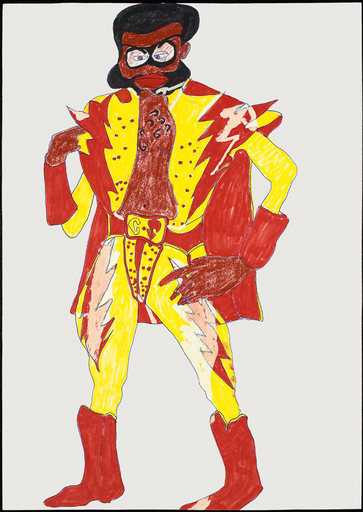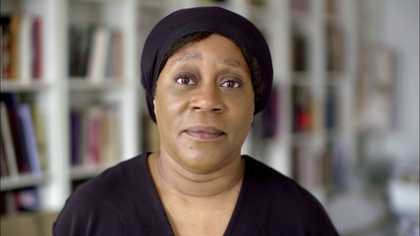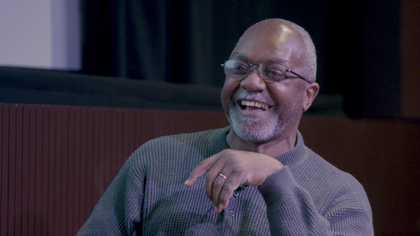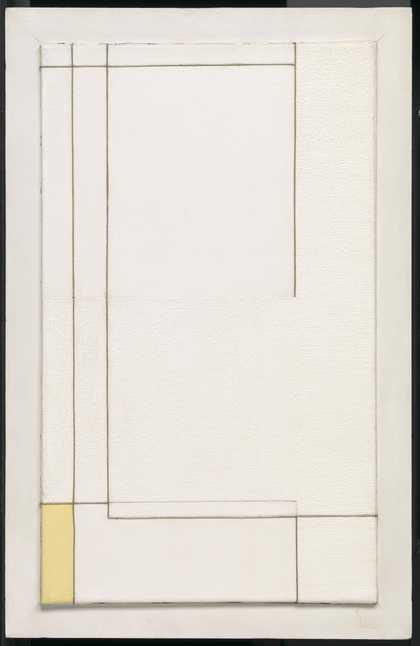Press play and discover Chris Ofili's painting No Woman, No Cry. Hear a detailed description of the artwork, descriptions of the colours and forms in the painting, and how the artist made the work.
Chris Ofili No Woman, No Cry 1998
No Woman, No Cry is a very large, densely layered painting that depicts a crying woman set among various abstract patterns. The canvas is 2.4m high by 1.8m wide. The woman, who has dark hair and black skin, is shown in profile. The portrait is formed from a thin brown painted outline that is filled with many small dark brown circles. She wears blue eye shadow, red lipstick, a string of coloured beads that sits just below her hairline and a thin black necklace.
Forming the pendant of her necklace is a lump of elephant dung studded with map pins and a black heart shape. The woman’s chest bears an area of vibrant red and orange paint, with flame-like yellow forks across its top edge. A series of pale blue tears descends from each of her eyes, all of which feature a very small collaged photograph of a boy’s face.
The background is painted with a mixture of pale green and bright yellow. There is a criss-cross pattern under the portrait, which is made up small circles. The dotted lines are punctuated by black heart shapes that appear at the centre of each of the criss-cross diamonds.
Running in four horizontal lines across the canvas, the words ‘RIP Stephen Lawrence 1974–1993’ appear very faintly underneath its top layer, with the dates at the bottom completely obscured by the shoulders of the woman.
When exhibited, the painting rests on two large lumps of elephant dung which are sealed in transparent resin and studded with coloured map pins that are placed on the floor. The painting’s upper edge leans against the gallery wall.
This painting was made by the British artist Chris Ofili in 1998 when he was living and working in London. The title of this work is the name of a 1974 song by the Jamaican reggae musician Bob Marley that asks a female listener not to be sad.
The faint inscription behind the portrait indicates that the crying woman is Doreen Lawrence (now Baroness Lawrence of Clarendon OBE), the mother of Stephen Lawrence. Stephen Lawrence was murdered as a teenage boy in an unprovoked racist attack in London in 1993, and the photographs inside the tears in this work are all images of Stephen.
The work is painted on a coarse linen canvas that was bought pre-primed. Ofili added several further layers of acrylic primer and then covered the entire canvas with light green acrylic paint. He then drew thin lines over it in pencil, before adding the collaged circles that make up the diamond pattern. The circles are small cut-out reproductions of a work by the British abstract artist Bridget Riley.
Ofili then applied the heart shapes in black oil paint and the black dots using rub-on transfers. Following this, he used more paint to write the text across the painting, before fixing the dung pendant onto the canvas with a glue gun.
A polyester resin mixed with glitter, orange and black pigments was then poured onto the work while it was positioned horizontally. The canvas was tipped up before drying, producing runs of resin that are visible around its edges.
Finally, thinned oil paint was applied to depict the woman and unthinned oils were used for the beads and the colours on her chest. Despite the many layers, the overall thickness is still sufficiently thin for the canvas texture to remain apparent through it.
After five years of campaigning by Lawrence’s parents, the then Home secretary, Jack Straw, announced a judicial inquiry into the police investigations into their son’s death. When it was published two years later the 1999 Macpherson Report found police conduct had been marred by professional incompetence and institutional racism. The report made seventy recommendations, which led to an overhaul of Britain’s race relations legislation.
Curator Judith Nesbitt has written that ‘Ofili was deeply moved by the way in which Doreen Lawrence’s overwhelming silent grief at her son’s tragic death had been transformed with each successive interview as she became even stronger in spirit and emboldened to speak with great dignity’.




